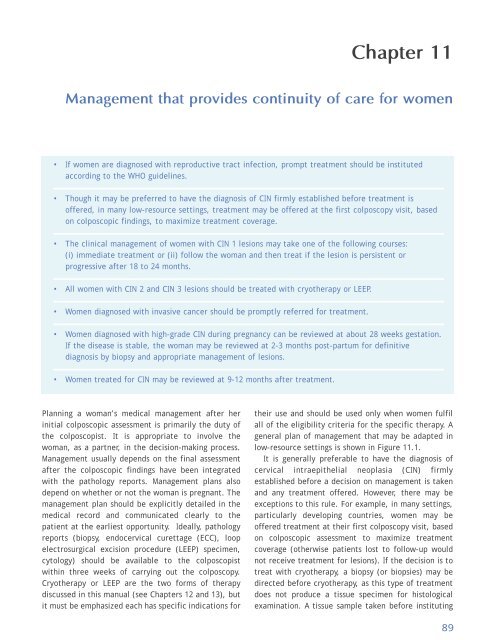Colposcopy and Treatment of Cervical Intraepithelial Neoplasia - RHO
Colposcopy and Treatment of Cervical Intraepithelial Neoplasia - RHO
Colposcopy and Treatment of Cervical Intraepithelial Neoplasia - RHO
You also want an ePaper? Increase the reach of your titles
YUMPU automatically turns print PDFs into web optimized ePapers that Google loves.
Chapter 11<br />
Management that provides continuity <strong>of</strong> care for women<br />
• If women are diagnosed with reproductive tract infection, prompt treatment should be instituted<br />
according to the WHO guidelines.<br />
• Though it may be preferred to have the diagnosis <strong>of</strong> CIN firmly established before treatment is<br />
<strong>of</strong>fered, in many low-resource settings, treatment may be <strong>of</strong>fered at the first colposcopy visit, based<br />
on colposcopic findings, to maximize treatment coverage.<br />
• The clinical management <strong>of</strong> women with CIN 1 lesions may take one <strong>of</strong> the following courses:<br />
(i) immediate treatment or (ii) follow the woman <strong>and</strong> then treat if the lesion is persistent or<br />
progressive after 18 to 24 months.<br />
• All women with CIN 2 <strong>and</strong> CIN 3 lesions should be treated with cryotherapy or LEEP.<br />
• Women diagnosed with invasive cancer should be promptly referred for treatment.<br />
• Women diagnosed with high-grade CIN during pregnancy can be reviewed at about 28 weeks gestation.<br />
If the disease is stable, the woman may be reviewed at 2-3 months post-partum for definitive<br />
diagnosis by biopsy <strong>and</strong> appropriate management <strong>of</strong> lesions.<br />
• Women treated for CIN may be reviewed at 9-12 months after treatment.<br />
Planning a woman’s medical management after her<br />
initial colposcopic assessment is primarily the duty <strong>of</strong><br />
the colposcopist. It is appropriate to involve the<br />
woman, as a partner, in the decision-making process.<br />
Management usually depends on the final assessment<br />
after the colposcopic findings have been integrated<br />
with the pathology reports. Management plans also<br />
depend on whether or not the woman is pregnant. The<br />
management plan should be explicitly detailed in the<br />
medical record <strong>and</strong> communicated clearly to the<br />
patient at the earliest opportunity. Ideally, pathology<br />
reports (biopsy, endocervical curettage (ECC), loop<br />
electrosurgical excision procedure (LEEP) specimen,<br />
cytology) should be available to the colposcopist<br />
within three weeks <strong>of</strong> carrying out the colposcopy.<br />
Cryotherapy or LEEP are the two forms <strong>of</strong> therapy<br />
discussed in this manual (see Chapters 12 <strong>and</strong> 13), but<br />
it must be emphasized each has specific indications for<br />
their use <strong>and</strong> should be used only when women fulfil<br />
all <strong>of</strong> the eligibility criteria for the specific therapy. A<br />
general plan <strong>of</strong> management that may be adapted in<br />
low-resource settings is shown in Figure 11.1.<br />
It is generally preferable to have the diagnosis <strong>of</strong><br />
cervical intraepithelial neoplasia (CIN) firmly<br />
established before a decision on management is taken<br />
<strong>and</strong> any treatment <strong>of</strong>fered. However, there may be<br />
exceptions to this rule. For example, in many settings,<br />
particularly developing countries, women may be<br />
<strong>of</strong>fered treatment at their first colposcopy visit, based<br />
on colposcopic assessment to maximize treatment<br />
coverage (otherwise patients lost to follow-up would<br />
not receive treatment for lesions). If the decision is to<br />
treat with cryotherapy, a biopsy (or biopsies) may be<br />
directed before cryotherapy, as this type <strong>of</strong> treatment<br />
does not produce a tissue specimen for histological<br />
examination. A tissue sample taken before instituting<br />
89
















